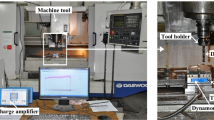Variable feed and variable speed machining is a significant method for improving the performance of cutting for hard and difficult to machine materials. Tests for optimising tool wear using variable feed and speed for drilling stainless steel using TiN-coated carbide drills are reported. This paper proposes the modelling of the feed and speed variations: f
(x) = f c [1+a sin(2π(x/L) + 3/2π)], ω(x) = ω c [1+b sin(π(x/L) + 3/2π)], respectively. The results indicate that variable feed machining is superior to constant feed machining with respect to tool life, burr height, and surface roughness. The amplitude of variation of feed, a = 0.8 and the amplitude of variation of speed, b = 0.07, is optimum for maximum tool life. The range of surface roughness from the variable feed and variable speed can be limited from 0.7 μm to 3 μm. The cutting-edge wear and outer corner wear were the dominant mechanisms of the drill wear.
Similar content being viewed by others
Author information
Authors and Affiliations
Rights and permissions
About this article
Cite this article
Lin, TR. Cutting Behaviour Using Variable Feed and Variable Speed when Drilling Stainless Steel with TiN-Coated Carbide Drills. Int J Adv Manuf Technol 19, 629–636 (2002). https://doi.org/10.1007/s001700200106
Issue Date:
DOI: https://doi.org/10.1007/s001700200106




